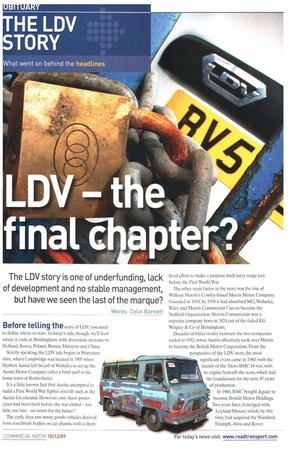final c
Page 48

Page 49

If you've noticed an error in this article please click here to report it so we can fix it.
The LDV story is one of underfunding, lack of development and no stable management, but have we seen the last of the marque?
Words: Colin Barnett
Before telling the story of LDV. you need
to define where to start. To keep it tidy, though, well start where it ends, in Birmingham, with diversions en route to Holland, Korea, Poland, Russia, Malaysia and China.
Strictly speaking, the LDV tale begins in Worcester ;hire, where Longhridge was located in 1905 when Herbert Austin left his job at Wolseley to set up the Austin Motor Company (after a brief spell in his home town of Rotherham).
It's a little known fact that Austin attempted to build a First World War fighter aircraft such as the Austin Greyhound. However, only three prototypes had been built before the war ended — too little, too late — an omen for the future?
The early days saw many goods vehicles derived from coach built bodies on car chassis, with a short lived effort to make a purpose-built lorry range just before the First World War.
The other main factor in the story was the rise of William Morris's Cowley-based Morris Motor Company Founded in 1910, by 1938 it had absorbed MG, Wolseley, Riley and Morris Commercial Cars to become the Nuffield Organisation. Morris Commercials was a separate company born in 1924 out of the failed EG Wrigley & Co of Birmingham.
Decades of bitter rivalry between the two companies ended in 1952, when Austin effectively took over Morris to become the British Motor Corporation. From the perspective of the LDV story, the most significant event came in 1960, with the launch of the lOcwt BMC J4 van, with its engine beneath the seats, which laid the foundations for the next 45 years of production.
In 1966, BMC bought Jaguar to become British Motor Holdings. Two years later, it merged with Leyland Motors, which, by this time, had acquired the StandardTriumph, Alvis and Rover brands. The result was the British Leyland Motor Corporation, led by Donald Stokes, which would eventually become a byword for all that ailed British industry.
In 1974, the J4 gained a long nose to house the engine under a conventional bonnet, and was initially known as the Leyland Van, renamed Leyland Sherpa a year later. In 1981, the Freight Rover division of the Land Rover Group within BL was created, which eventually became a part of the Leyland Tl-ucks division. By 1984, the van was known as the Freight Rover 200-series and had gained a wide-bodied version — the 300-series.
Rebranding
Political problems at BL in the late-70s and early-80s saw a renaming in 1986 to the less stigmatic Rover Group, then, in 1987, Leyland Trucks merged with DAF Trucks to form a Dutch-registered
company, DAF NV, trading in the UK as Leyland DM.. DAF NV collapsed in 1993,A subsequent management buy-out created Leyland DAF Vans Lid, under chief executive Allan Amey, but it was soon renamed LDV Ltd.
Apart from rebranding the 200-series as Pilot and the 300-series as Convoy, and a period selling the Nissan Vanette Cargo as the LDV Cub, the product range remained unchanged. The ageing line-up needed updating, but even the biggest companies were finding it too expensive to develop new models on their own.
LDV's solution was to embark on a joint venture with the Daewoo company to design a new van range, but in 2000 the Korean business collapsed taking the project with it. Alt was not lost, though, and LDV eventually bought the design and Polish production line, where Daewoo's version was to be built, from new owner General Motors.
In 2005, from a production line set up at a surprisingly well-modernised Drews Lane, came the first all-new LDV product, the Maxus, 'the extended gestation period meant the Maxus was perceived by many as dated from the outset, but it sold respectably while never achieving the volumes needed for sufficient profitability. By December 2005, the company was effectively bust again and was bought by American venture capitalists, Sun Capital. In 2006, Russian van-maker GAZ bought the company amid plans to extend the Maxus market throughout western and eastern Europe.
From then until late 2008, the company soldiered on, with prototypes and plans for new models, including a 7.5-tonner and an electric van, but when the company shut for the 2008 Christmas break, it looked increasingly unlikely that it would ever make another van.
Despite months of pleading for state aid to fund another management buyout, LDV's unstable history in an over-crowded market and the well-publicised relationship between billionaire GAZ boss Oleg Deripaska and UK business secretary Lord Mandelson meant the Brown government was never really likely to provide the funds.
For a while, it looked as if Malaysian importer Weststar would come to the rescue, but, as negotiations dragged on through 2009, this became increasingly unlikely. In October, it was eventually bought by Chinese buyer, Eco Concept.
Despite views from the optimists among the workforce that "we've been here before and bounced back7this does indeed seem to be the final chapter.
If LDV has actually gone, it will be a very long time before it is forgotten. •








































































































































